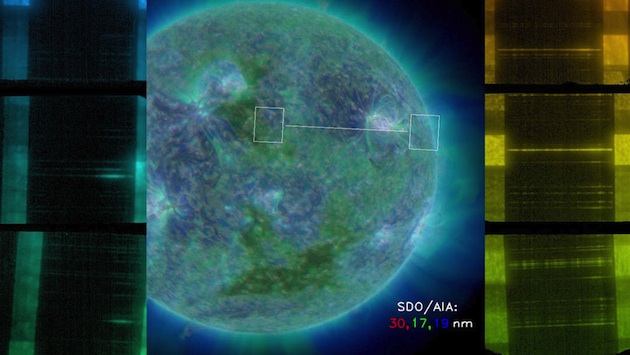
A NASA sounding rocket examined light from the sun in the area shown by the white line (imposed over an image of the sun from NASA's Solar Dynamics Observatory) and then separated the light into various wavelengths, as shown in the lined images – spectra – on the right and left, to identify the temperature of material observed on the sun. The spectra provided evidence to explain why the sun's atmosphere is so much hotter than its surface. Photo courtesy of NASA/EUNIS/SDO
Rice, NASA, Glasgow researchers find evidence of why solar atmosphere is hotter than surface
New research by NASA, Rice University and the University of Glasgow details the first solid evidence of why the sun’s atmosphere is 300 times hotter than its 10,340-degree Fahrenheit surface.
The answer, according to Rice astrophysicist Stephen Bradshaw and his colleagues, involves intermittent “nanoflares,” bursts of hot plasma in the corona that have a billion times less energy than regular flares but still reach temperatures of 18 million degrees Fahrenheit.
Despite being tiny by solar standards, each nanoflare “packs the wallop of a 10-megaton hydrogen bomb,” said principal investigator Jim Klimchuk, a solar scientist at NASA’s Goddard Space Flight Center in Maryland. “Millions of them are going off every second across the sun, and collectively they heat the corona.”
The scientists delivered their results at the first Triennial Earth-Sun Summit in Indianapolis April 28.
“Nanoflares have been so difficult to spot because the plasma they heat has a low initial density,” said Bradshaw, an assistant professor of physics and astronomy. “It doesn’t emit much radiation for us to detect and cools very quickly, so the signals don’t last long.”
NASA gathered the new evidence with sounding rockets, which launch instruments above the atmosphere on suborbital flights. A 15-minute flight in 2013 carried a spectrograph tuned to spot how much material is present at a given temperature. The spectrograph found unambiguous evidence for the presence of nanoflares in otherwise quiet regions of the corona.
X-ray images of the corona from rockets launched in 2012 and 2013 also saw evidence of the super hot plasma.
Bradshaw, who recently earned a National Science Foundation CAREER award to continue his research of the sun’s atmosphere, used a sophisticated computational model to demonstrate why spotting signatures of the nanoflares has been so difficult and how the new evidence will help heliophysics researchers ultimately solve the coronal heating mystery.
What remains is the question of how the nanoflares accumulate so much energy before bursting.
“This work will help us to pin down the properties of nanoflares — the energy released, heating time and inter-event frequency — to provide clues and guide us toward identifying the mechanism that drives them,” Bradshaw said.



Leave a Reply